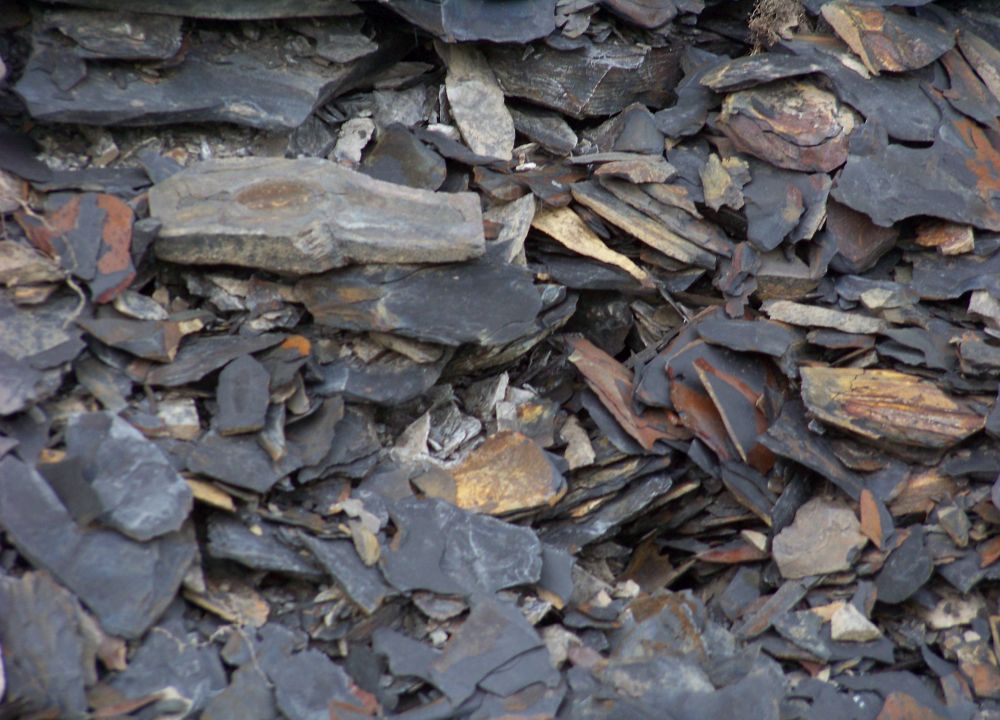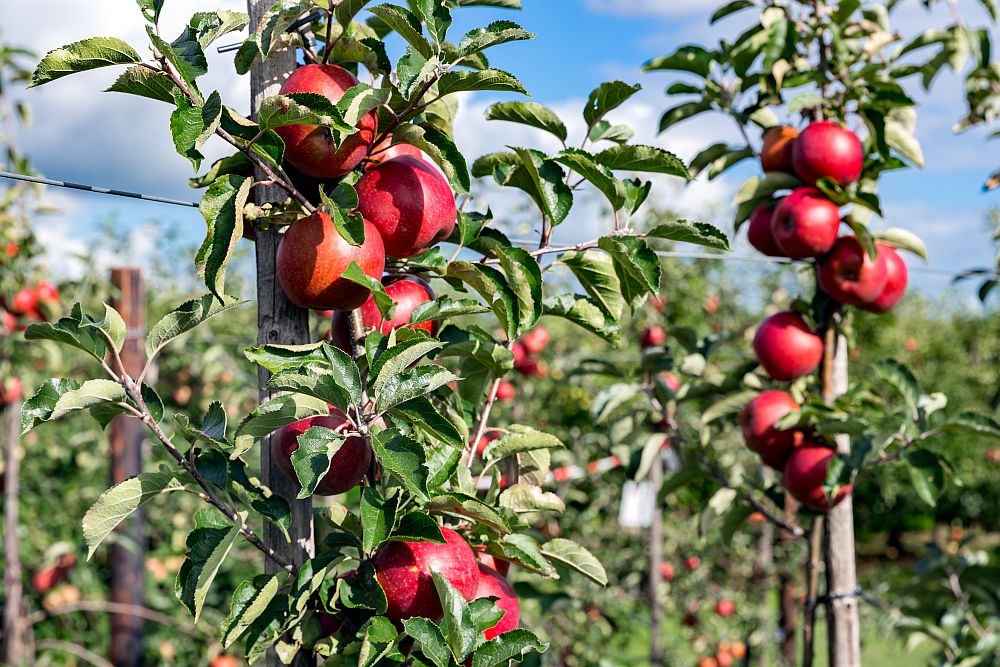
[Image above] Close-up picture of shale in the Marcellus Formation along Route 174 just south of Slate Hill Road. Artist and teacher Jennie Shanker conducted an experiment to see if this shale could be used as a clay substitute in studio ceramics. Credit: Lvklock, Wikimedia Commons (CC BY-SA 3.0)
This geologist’s favorite class of minerals are the phyllosilicates. These minerals, also known as sheet silicates, are characterized by their layered structure, formed by interconnected sheets of silicate tetrahedra.
The mica group of phyllosilicates, which are used in everything from cosmetics to electronics, is probably one of the most familiar types. Its applications even show up in popular children’s literature—I read about isinglass (thin and flexible layers of muscovite mica) in Laura Ingalls Wilder’s Little Town on the Prairie, where it was mentioned as the window material in wood stoves!
I had a collection of micas growing up, and I even entertained Mica as a name for an eventual child. (My kids are grateful that didn’t happen.) But my first physical interaction with the phyllosilicates was through the vermiculite my mother added to potting soil and garden soil. The layers in the little pellets would compress under the pressure of my fingers, fascinating me.
The layers in phyllosilicate minerals are what give clay its remarkable plasticity and strength. But the exact arrangement of layers in various phyllosilicates differs in important ways. Kaolinite,* for example, is a 1:1 phyllosilicate, meaning it consists of alternating layers of tetrahedral and octahedral sheets. In contrast, the smectite clays and illite clays are 2:1 phyllosilicates, meaning they have two layers of tetrahedral sheets for each octahedral sheet.
*Side note: I just recently learned that kaolin is a loan word from Chinese, which my college Chinese professor would probably laugh at me for admitting at this late date. Kaolin is the anglicization—by way of French—of gāolǐngtǔ, meaning high ridge clay.
Often, clays will contain mixed and alternating layers of different phyllosilicates and other clay minerals. This jumbled structure is due to how clays are formed: by chemical weathering or alteration (hydrothermal or metamorphic) of existing rock. Each of these components has unique properties based on their chemical composition, so manufacturers must carefully consider the geology when surveying new or alternative sources of clay.
Considering the importance of clay composition in manufacturing, this CTT looks at the geological processes involved in turning rock into clay—and, potentially, reconstituting clay after it has been lithified into mudstone or shale.
Formation of clay
The geologic process of clay formation is a long one. Most clay minerals have feldspar or another silicate mineral such as pyroxene, amphibole, or olivine as their source material. The silicates are the most abundant class of minerals on Earth (and, apparently, also on Mars).
Earth’s crust (the surface) is almost entirely made of silicate minerals—only 8% of the crust is made of another class of minerals. These minerals are broken down into clay over time by chemical and physical weathering, which occurs under different conditions of temperature, pressure, water or oxygen content, and pH.
Transition from clay to mudstone or shale
Clay is incredibly abundant because the phyllosilicate minerals from which it is derived are so abundant themselves. In the United States, the list of places where clay is not abundant is easier to remember: the Colorado Plateau, the Southern High Plains of west Texas and New Mexico, the glaciated parts of Michigan, and the Sand Hills of Nebraska. In most places on Earth, if you have soil, you have a 15–25% chance of finding clay if you dig around enough.
The interesting thing about life on this planet for me, as an observer with a geology background, is how dynamic Earth’s systems are. A clay formed by weathering from an igneous or metamorphic rock will eventually get compacted and become a layered sedimentary rock known as mudstone or shale. Mudstone and shale have the same composition, but mudstone fractures into blocks and shale fractures in layers.
Mudstones and shales account for 70% of all sedimentary rock on Earth. They form in shallow or deep, but calm, waters. It is a low-energy, slow process that contrasts with the ceramic firing process.
Ceramicists and potters accelerate the process of lithifying clay by using a kiln to drive out the water and create crosslinks among the clay particles. These crosslinks are what prevent fired clay from being recycled into new pots. Organic matter in the clay is burned and oxidized, and the clay material is sintered and welded together.
Reconstituting clay from mudstone and shale
Although it isn’t possible to turn pottery back into raw clay (yet), the slow formation process of shale, in contrast to ceramic firing, allows it to be crushed and mixed with water for use as clay and glaze in studio ceramics. (If you like to experiment with glazes, this informative video will help you understand the geology behind the types and colors that can be made.)
When I first started writing this CTT, I was not aware that shale was commonly used as a clay source. But during my investigations to see if it was possible, I found a Reddit thread that talked about an interesting shale study called the Marcellus Clay Experiment.
The Marcellus Clay Experiment was conducted by artist and teacher Jennie Shanker, a resident of Philadelphia, Pa. In 2011, while working on a project in the Catskill region of New York, she noticed the lovely red shale at her feet and wondered if it could be used as a studio ceramic. Her curiosity led to the collaborative Marcellus Clay Experiment, which involved sourcing shale from the infamous Marcellus Shale, the largest natural gas field in the United States.
I knew about the Marcellus Shale, so I was definitely intrigued by this experiment. Details of the experiment can be found in an interview with Shanker published in Ceramics Monthly. One thing Shanker made sure to emphasize is that although cups made from the mildly radioactive shale pose no risk to human health, a larger discussion about hydraulic fracturing (fracking) in the Marcellus Shale needs to be had. (If you’ve watched the documentary GasLand, you have been introduced to the Marcellus Shale, too.)
The next time you work with clay, I hope you take a moment to appreciate its geological origins and consider—which clay mineral will become your favorite?
Author
Becky Stewart
CTT Categories
- Environment


